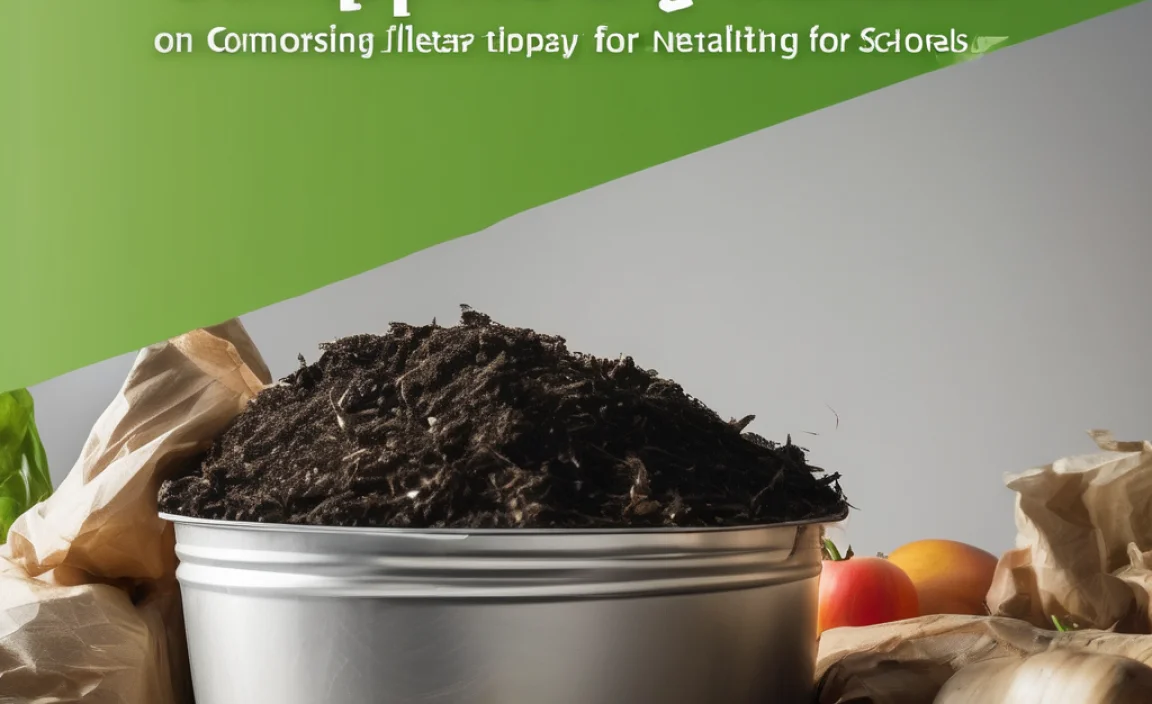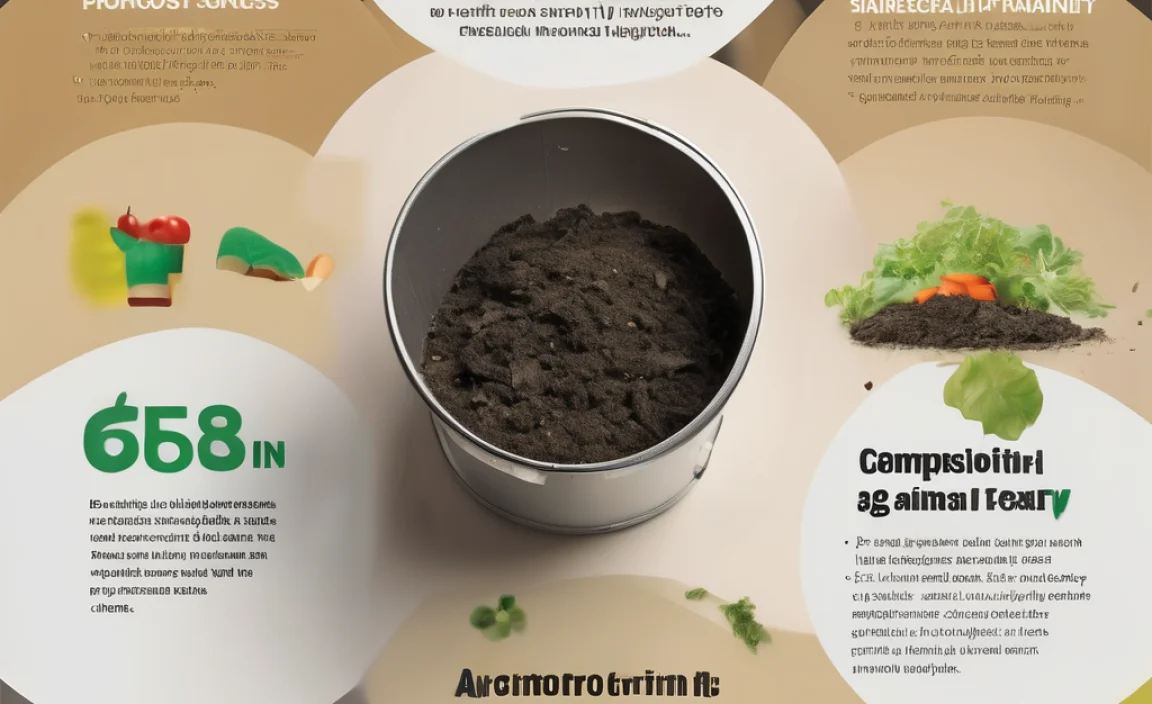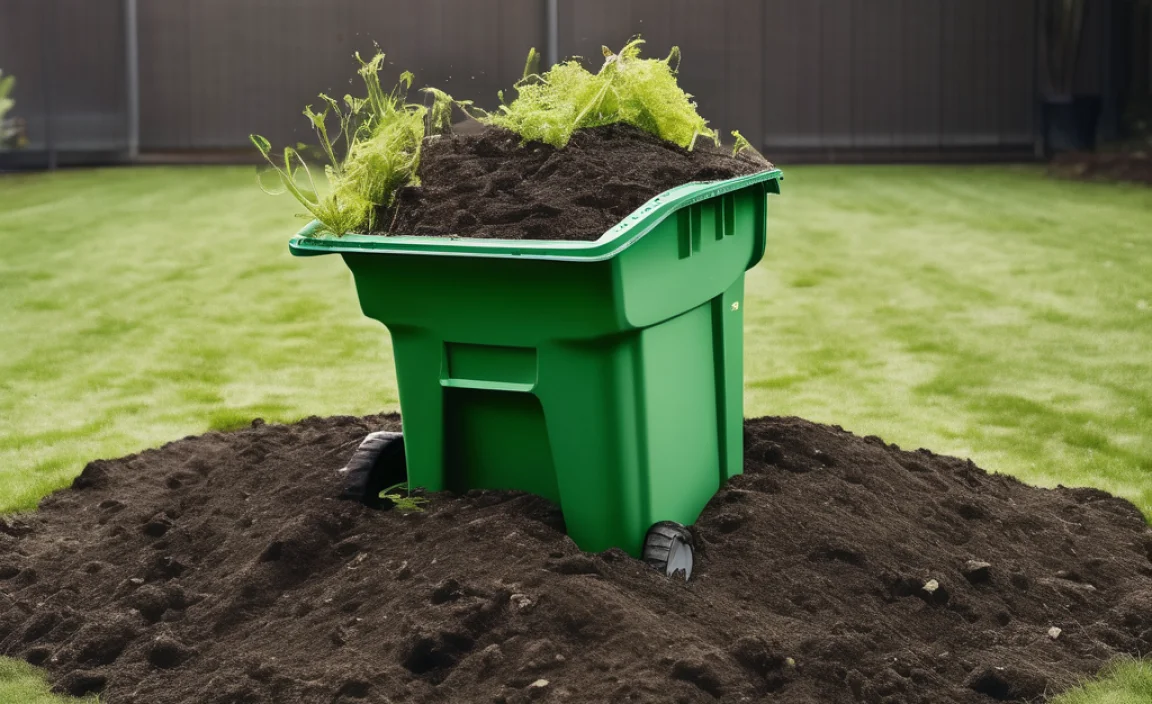Hey there, aspiring school compost champions! Ever feel like your school’s cafeteria scraps and yard waste are just … going to waste? It’s a common sight, and honestly, a bit of a bummer when you think about all that organic goodness ending up in the landfill. But what if I told you there’s a super achievable way to turn that “waste” into something amazing – rich soil for your school gardens, or even just a cleaner conscience about your environmental footprint?
You’re in the right place! We’re going to break down exactly how to get composting at your school, step by simple step. No fancy degrees needed, just a willingness to get a little dirt under your fingernails and make a big difference. We’ll cover everything from picking the right system to getting everyone involved. Stick around, and you’ll see just how proven success in school composting can be!
Why Composting Rocks for Schools: More Than Just Less Trash

Let’s talk about why bringing composting into your school isn’t just a cute idea; it’s a genuinely smart move. Think about it: schools generate a ton of organic stuff every single day. Lunchrooms are a goldmine of food scraps, and school grounds often have plenty of leaves and grass clippings piling up. When all that goes to the landfill, it takes up space and, worse, it decomposes without oxygen, releasing harmful greenhouse gases like methane. Yikes!
Composting offers a brilliant alternative. It’s nature’s way of recycling, turning waste into a valuable resource. For schools, this means:
- Reducing Waste: Significantly cuts down on what goes into your school’s trash bins, saving money on waste disposal.
- Environmental Benefits: Less methane produced means a healthier planet. Plus, compost enriches soil, which helps plants grow better and retain more moisture.
- Educational Opportunities: It’s one of the best hands-on science lessons you can offer! Kids learn about biology, ecology, and sustainability in a super engaging way.
- School Gardens Bloom: If your school has a garden, compost is like superfood for it, leading to healthier plants and bigger harvests.
- Cost Savings: Reduced waste hauling fees and free, high-quality soil amendment can lead to real savings for the school’s budget.
Getting started might seem like a big undertaking, but with a clear plan, it’s totally manageable. We’re going to walk through it together, making sure you have all the info you need to make composting a success story at your school.
Step 1: Building Your Composting Dream Team and Getting Buy-In

Before you even think about bins or materials, the most crucial first step is people power! You need a team that’s excited and supportive. This isn’t a one-person job. Think about who could be your allies:
- Students: They are often the most enthusiastic participants and can be amazing ambassadors for the program. Look for eco-clubs, science classes, or even just a group of motivated volunteers.
- Teachers: Science teachers are a natural fit, but environmental science, home economics, or even art teachers might find ways to integrate composting into their curriculum.
- Custodial Staff: These are the folks who deal with the daily waste. Their knowledge of school operations and their buy-in are invaluable. They can also help with transportation of materials.
- Cafeteria Staff: They manage the food scraps, so working with them to separate items is key.
- School Administrators: Getting principals, vice-principals, or the school board on board is vital for official approval, support, and any potential funding or resource allocation.
- Parent Volunteers: Parents can offer a wealth of support, from fundraising to helping with collection days.
How to Garner Support: The Pitch
When you’re talking to potential stakeholders, focus on the benefits we just discussed. Tailor your pitch:
- To Administrators: Emphasize cost savings, positive PR, educational value, and meeting sustainability goals.
- To Teachers: Highlight the hands-on learning opportunities that can enhance their curriculum.
- To Students: Talk about making a real difference, creating cool projects, and a cleaner environment.
- To Custodial/Cafeteria Staff: Explain how the program can simplify their waste management and potentially reduce their workload in the long run.
Don’t forget to mention that you’re aiming for a composting for schools step by step approach, making it manageable and allowing for growth. Highlighting success stories from other schools can also be very persuasive.
Step 2: Deciding on Your Composting Method: Which Bin is Right for You?

Okay, you’ve got your team and the green light. Now, let’s talk about how you’ll actually do the composting. There isn’t a one-size-fits-all answer. The best system for your school depends on space, the amount of material you think you’ll generate, and your budget. Here are some popular options:
Option A: The Outdoor Tumbler or Bin System
This is often a great starting point for schools with some outdoor space. Tumblers are enclosed, rotating bins that speed up the composting process and help keep pests out. Stationary bins are simpler, often made of wood or recycled plastic, and require a bit more manual turning.
- Pros: Relatively easy to manage, can handle a good volume of material, good for schools with outdoor space. Tumblers are cleaner and faster.
- Cons: Requires outdoor space, might need regular turning, stationary bins could attract pests if not managed well.
Option B: The Aerated Static Pile (ASP)
This is a more advanced method, often used for larger-scale operations, but can be adapted. It involves piling organic materials up and then using a fan to blow or suck air through the pile. It’s fast and effective for compost larger volumes.
- Pros: Very efficient for large volumes, can be quick, good control over the composting process.
- Cons: Requires more technical knowledge, needs electricity for fans, higher initial setup cost.
Option C: Vermicomposting (Worm Composting)
Yes, worms! Red wiggler worms can process food scraps surprisingly quickly in special bins. This is fantastic for smaller schools or for educational purposes specifically focused on food waste from the cafeteria.
- Pros: Great for food scraps, can be done indoors or outdoors, highly engaging for students, produces nutrient-rich worm castings.
- Cons: Can only process certain types of food scraps (no meat, dairy, or oily foods), requires managing living creatures, might not handle large volumes of yard waste.
Option D: Using a Commercial Composter
For schools with a significant budget and a large volume of waste, there are commercial composting systems available. These are often automated and designed for high throughput.
- Pros: High capacity, often very efficient, can be fully contained.
- Cons: Very high cost, may require specialized training to operate.
Our Recommendation for Beginners: For most schools starting out, a few well-managed outdoor tumblers or stationary bins are usually the most practical and cost-effective way to begin exploring composting for schools step by step. Vermicomposting can be a fantastic supplement or starting point for a specific classroom project.
Essential Tools for Composting Success:
No matter which system you choose, you’ll likely need a few basic tools:
- Compost Bins/Tumblers: Your primary containment.
- Pitchfork or Compost Aerator: For turning the compost.
- Shovels: For moving materials.
- Wheelbarrow: To transport scraps and finished compost.
- Water Source: Compost needs to be kept moist.
- Gloves: For hygiene.
- Collection Bins: Small bins for kitchens and classrooms to collect scraps.
- Signage: Clear signs explaining what can and cannot be composted.
Step 3: Setting Up Your Composting Station

This step is all about creating the “home” for your compost. Location, location, location!
Choosing the Right Spot:
- Accessibility: It needs to be easy for students and staff to bring materials to, but also for the composting team to work with.
- Sunlight/Shade: A balance is good. Too much direct sun can dry it out too quickly, while too much shade might keep it too wet. A partially shaded spot is often ideal.
- Water Access: You’ll need to add water, so being close to a hose spigot is a big plus.
- Drainage: Make sure the area doesn’t flood. You don’t want your compost pile sitting in a puddle.
- Proximity to Odor Sensitive Areas: While a well-managed compost pile shouldn’t smell bad, it’s wise to keep it away from windows or sensitive areas of the school.
Preparing the Bins/Tumblers:
If you’re using stationary bins, you might want to place them directly on soil or a base of wood chips. This allows beneficial microbes and earthworms from the soil to enter your compost pile. Ensure there’s some airflow around the base.
For tumblers, simply assemble them according to the manufacturer’s instructions. Make sure they are stable and easy to rotate.
What Can and Cannot Be Composted? Know Your Greens and Browns!
This is super important for creating healthy compost and avoiding smells or pests. Compost heaps need a good balance of nitrogen-rich materials (called “greens”) and carbon-rich materials (called “browns”). Aim for a ratio of roughly 2-3 parts browns to 1 part greens.
Good “Greens” (Nitrogen-Rich):
- Fruit and vegetable scraps
- Coffee grounds and tea bags
- Grass clippings
- Plant trimmings (non-woody)
- Eggshells
Good “Browns” (Carbon-Rich):
- Dry leaves
- Straw
- Cardboard (torn into small pieces)
- Paper (shredded, non-glossy)
- Sawdust (from untreated wood)
- Wood chips
What to AVOID in MOST School Composting Systems:
- Meat, fish, and bones
- Dairy products
- Oily or greasy foods
- Diseased plants
- Weeds that have gone to seed
- Pet waste (from cats or dogs)
- Treated wood
- Glossy or coated paper/cardboard
Always check with your local waste management or composting experts for specific guidelines. The US Environmental Protection Agency (EPA) offers excellent resources on composting basics that can be adapted for school settings.
Setting Up Collection Points:
Place clearly labeled collection bins in strategic locations: the cafeteria, staff rooms, and possibly some classrooms. Make sure the labels are very clear with pictures of what belongs and what doesn’t.
Train students and staff on what goes into the bins. This is where your “team” outreach really pays off!
Step 4: The Art of Layering and Maintaining Your Compost Pile

This is where the magic happens! Composting is about creating the right environment for microorganisms to do their work.
Getting Started: Building Your First Pile
Don’t just dump everything in one go. A good start helps the process:
- Base Layer of Browns: Start with a layer of coarse brown material like straw or small twigs at the bottom of your bin. This helps with airflow and drainage.
- Add Greens: Add a layer of your collected kitchen and cafeteria scraps (fruits, veggies, coffee grounds).
- Cover with Browns: Always cover your green layer with a generous layer of brown material (dry leaves, shredded paper/cardboard). This is key to preventing odors and deterring pests.
- Add Water: Lightly moisten the layers as you go. The compost should feel like a damp sponge – not soggy, not dry.
- Repeat: Continue alternating layers of greens and browns as you add more material.
The Crucial Elements: Air, Moisture, and Microbes
Think of it like this: your compost pile needs food, water, and air to thrive.
- Air (Aeration): Microbes that break down organic matter need oxygen. If the pile is too compacted, it can become anaerobic (lacking oxygen), leading to foul smells.
- How-to: Regularly turn your compost pile. For tumblers, give them a spin every few days. For stationary bins, use a pitchfork to mix the layers weekly or bi-weekly. You can also use a compost aerator tool.
- Moisture: Microorganisms need water to live and work.
- How-to: Check the moisture level regularly. It should feel like a wrung-out sponge. If it’s too dry, add water while turning. If it’s too wet (especially after rain), add more brown materials to absorb excess moisture and turn it.
- Microbes: These are the tiny workers doing the heavy lifting. They are naturally present in soil and on organic materials.
- How-to: By adding materials from soil or finished compost, you can introduce more helpful microbes. The balance of greens (food) and browns (energy source) also helps them flourish.
What to Expect: The Stages of Composting
Composting is a natural process that happens in stages:
| Stage | Temperature | Appearance | Process |
|---|---|---|---|
| Mesophilic Stage | Warm (below 104°F / 40°C) | Materials visible, starting to break down | Initial breakdown by mesophilic microbes. |
| Thermophilic Stage | Hot (131-160°F / 55-71°C) | Materials becoming less recognizable, steam may be visible | High-activity breakdown by thermophilic microbes. Kills weed seeds and pathogens. |
| Cooling/Curing Stage | Ambient temperature | Dark, crumbly, earthy smell | Mesophilic microbes return; compost matures. |
The time it takes to reach finished compost varies wildly – from a few weeks to several months, depending on how actively you manage it, the materials used, and the weather. Patience is a virtue here!
Step 5: Harvesting Your Finished Compost and Using It
The payoff! Knowing when your compost is ready is key. Your finished compost should look and smell like dark, crumbly soil. You shouldn’t be able to recognize most of the original materials. It should have a pleasant, earthy aroma, not a sour or ammonia-like smell.
How to Harvest:
- From Tumblers: Many tumblers have a door at the bottom for harvesting. Simply open it and collect the finished compost. You might need to sift out any larger, unfinished pieces.
- From Stationary Bins: The compost at the bottom and sides is usually the most mature. You can carefully shovel out the finished compost from the bottom or sides, leaving unfinished material in the pile to continue breaking down.
What to Do with Your Compost Gold:
This is the exciting part where you see the direct benefit of your hard work!
- School Gardens: Mix compost into the garden beds to improve soil structure, fertility, and water retention. Students can literally see their food waste turn into food for plants! The KidsGardening Foundation has fantastic resources for school gardening projects that can integrate compost use.
- Potting Mix: Mix compost 1:1 with potting soil for container plants around the school.
- Mulch: Spread a layer of compost around trees and shrubs to help retain moisture and suppress weeds.
- Educational Demonstrations: Use finished compost for science lessons demonstrating soil health and decomposition.
What to Do with Unfinished Material:
Don’t worry if some material isn’t fully composted. You can simply add it back to a new compost bin or to the active pile to continue breaking down. Sifting can help separate the finished compost from the unfinished bits.
.lwrp.link-whisper-related-posts{
margin-top: 40px;
margin-bottom: 30px;
}
.lwrp .lwrp-title{
}.lwrp .lwrp-description{
}
.lwrp .lwrp-list-container{
}
.lwrp .lwrp-list-multi-container{
display: flex;
}
.lwrp .lwrp-list-double{
width: 48%;
}
.lwrp .lwrp-list-triple{
width: 32%;
}
.lwrp .lwrp-list-row-container{
display: flex;
justify-content: space-between;
}
.lwrp .lwrp-list-row-container .lwrp-list-item{
width: calc(25% – 20px);
}
.lwrp .lwrp-list-item:not(.lwrp-no-posts-message-item){
max-width: 150px;
}
.lwrp .lwrp-list-item img{
max-width: 100%;
height: auto;
object-fit: cover;
aspect-ratio: 1 / 1;
}
.lwrp .lwrp-list-item.lwrp-empty-list-item{
background: initial !important;
}
.lwrp .lwrp-list-item .lwrp-list-link .lwrp-list-link-title-text,
.lwrp .lwrp-list-item .lwrp-list-no-posts-message{
}@media screen and (max-width: 480px) {
.lwrp.link-whisper-related-posts{
}
.lwrp .lwrp-title{
}.lwrp .lwrp-description{
}
.lwrp .lwrp-list-multi-container{
flex-direction: column;
}
.lwrp .lwrp-list-multi-container ul.lwrp-list{
margin-top: 0px;
margin-bottom: 0px;
padding-top: 0px;
padding-bottom: 0px;
}
.lwrp .lwrp-list-double,
.lwrp .lwrp-list-triple{
width: 100%;
}
.lwrp .lwrp-list-row-container{
justify-content: initial;
flex-direction: column;
}
.lwrp .lwrp-list-row-container .lwrp-list-item{
width: 100%;
}
.lwrp .lwrp-list-item:not(.lwrp-no-posts-message-item){
max-width: initial;
}
.lwrp .lwrp-list-item .lwrp-list-link .lwrp-list-link-title-text,
.lwrp .lwrp-list-item .lwrp-list-no-posts-message{
};
}
